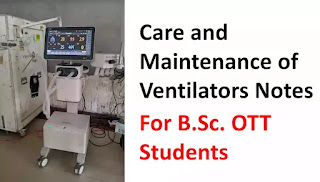Care and Maintenance of Ventilators Notes
 |
| Care and Maintenance of Ventilators Notes |
Question: Explain the importance of proper care and maintenance of ventilators. Provide a comprehensive overview of the key steps involved in maintaining ventilators for optimal functionality. (14 marks)
Introduction:
Ventilators are indispensable life-saving medical devices
used to provide respiratory support to critically ill patients. Proper care and
maintenance of ventilators are crucial not only for ensuring the well-being of
patients but also for the longevity and optimal functionality of the equipment.
Neglecting maintenance can lead to device malfunction, compromised patient
safety, and increased healthcare costs.
Importance of Proper Care and Maintenance:
Patient Safety:
Ventilators directly
influence patient health and outcomes. Well-maintained ventilators ensure
accurate delivery of air pressure, oxygen levels, and tidal volumes, preventing
potential harm to patients.
Reliability:
Regular maintenance
reduces the risk of equipment breakdown during critical moments. In emergency
situations, a properly functioning ventilator can be the difference between
life and death.
Optimal Performance:
Accurate settings and calibrated sensors ensure that patients
receive the precise respiratory support they require, leading to improved
oxygenation and ventilation.
Key Steps in Ventilator Maintenance:
Environmental Considerations:
Ensure the ventilator is placed in an appropriate
environment. Avoid exposing the device to excessive dust, humidity, or direct
sunlight. Proper environmental conditions contribute to the longevity of the
equipment and prevent premature wear.
Daily Pre-use Inspection:
Before each use,
perform a visual inspection of the ventilator. Check for physical damage, loose
connections, and signs of wear. Ensure the device is ready for safe operation.
Cleaning and Disinfection:
Regular cleaning using hospital-approved agents is essential
to prevent contamination. Wipe down external surfaces, screens, buttons, and
touch interfaces. For the breathing circuit, adhere to a cleaning schedule and
follow manufacturer guidelines. Replace filters and clean humidification
components to maintain air quality.
Calibration and Performance Checks:
Regular calibration
ensures accurate settings and sensor readings. Perform performance checks using
appropriate testing equipment to verify that the ventilator operates within
specified parameters.
Ventilator Alarms and Settings Review:
Regularly review and
understand the meaning of different alarms that the ventilator may produce.
Ensure that staff are trained to respond appropriately to alarms. Periodically
verify and document the accuracy of ventilator settings to ensure patient safety.
Battery and Power Backup Testing:
Test and monitor the backup power source (usually batteries)
to ensure they are functional in case of power outages. Regularly replace
batteries according to the manufacturer's recommendations and confirm that the
power backup system works as intended.
Ventilator Transport and Storage:
Establish proper protocols for transporting
ventilators within the healthcare facility or during patient transfers. Secure
all components, disconnect the power source, and protect the device from
physical damage. Store ventilators in a clean and dry environment when not in
use.
Troubleshooting and Maintenance:
Familiarize staff
with common issues like alarms, sensor malfunctions, and disconnected tubing.
Develop a maintenance schedule that includes tasks such as lubricating moving
parts, inspecting cables, and checking connections.
Documentation and Record-Keeping:
Maintain detailed records of maintenance tasks, calibration
results, and repairs. This documentation aids in accountability, tracks
equipment history, and assists in identifying recurring issues.
Staff Training and Responsibilities:
Provide comprehensive training to healthcare staff on
ventilator use, care, and troubleshooting. Designate roles and responsibilities
for ventilator maintenance within the healthcare team.
Manufacturer's Guidelines:
Follow the
manufacturer's instructions for care and maintenance. Consult user manuals and
technical documents for specific guidance on cleaning agents, procedures, and
maintenance intervals.
In-Service Training and Ongoing Education:
Conduct regular
in-service training sessions for healthcare staff to refresh their knowledge of
ventilator care and maintenance. Stay updated on new advancements and
guidelines in ventilator technology through ongoing education, workshops, and
manufacturer updates.
Remote Monitoring and Support:
Utilize remote
monitoring technology provided by some ventilators. This allows biomedical
engineers or technical support teams to diagnose issues remotely and provide
guidance for troubleshooting, reducing downtime and the need for on-site
repairs.
Spare Parts Management:
Maintain an inventory
of essential spare parts such as tubing, connectors, filters, and sensors.
Having readily available spare parts ensures quick replacement in case of
failure and minimizes interruptions in patient care.
Regular Ventilator Rotation:
Implement a rotation system for using ventilators to distribute wear and tear evenly across devices. This prevents overuse of specific ventilators and prolongs their overall lifespan.
In conclusion, the proper care and maintenance of
ventilators are of paramount importance for patient safety, equipment
reliability, and optimal performance. Healthcare professionals should adhere to
rigorous maintenance protocols to ensure that ventilators are consistently
ready to provide critical respiratory support to those in need. This diligence
not only safeguards patient lives but also contributes to the efficient
functioning of healthcare systems.
Recommended Topics
Label List
- BASIC CONCEPTS (19)
- ANESTHESIA EQUIPMENTS (18)
- Exam (13)
- study material (12)
- MCQ FOR OT TECHNICIANS (11)
- ANESTHESIA PREPRATION (10)
- DEVICES USED IN OT (7)
- random topics (7)
- CSSD & OTHER DEVICES (6)
- FIND A JOB (5)
- QUESTION PAPERS (5)
- latest updates (4)
- DRUGS (3)
- PATIENT CARE (3)
- Registration (3)
- Surgical Instruments (3)
- History of Anesthesia (2)
- by - Ritika Sharma (1)

Post a Comment
Post a Comment